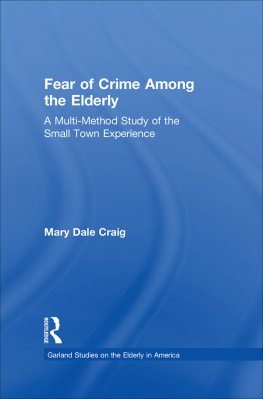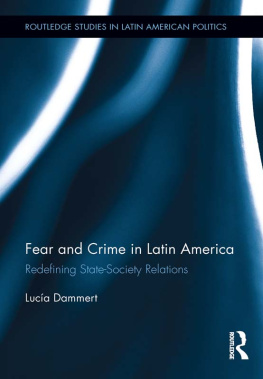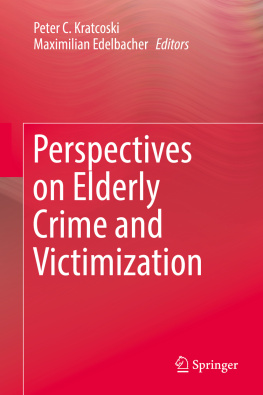Published in 2000 by
Garland Publishing, Inc.
A member of the Taylor & Francis Group
29 West 35th Street
New York, NY 10001
Copyright 2000 by Mary Dale Craig
All rights reserved. No part of this book may be reprinted or reproduced or utilized in any form or by any electronic, mechanical, or other means, now known or hereafter invented, including photocopying and recording, or in any information storage or retrieval system, without written permission from the publishers.
10 9 8 7 6 5 4 3 2 1
Library of Congress Cataloging-in-Publication Data
Craig, Mary Dale.
Fear of crime among the elderly : a multi-method study of
the small town experience / Mary Dale Craig.
p. cm. (Garland studies on the elderly in America)
Includes bibliiographical references and index.
ISBN 0-8153-3784-1 (alk. paper)
1. Fear of crimeUnited StatesCase studies. 2. AgedCrimes againstUnited StatesCase studies. 3. AgedUnited StatesInterviews. 4. Victims of crimes surverysUnited States. I. Title. II. Series.
HV6250.4.A34 C73 2000
362.880846dc21
00-035349
Printed on acid-free, 250 year-life paper
Manufactured in the United States of America
To my parents, whose loving encouragement has been bestowed upon me in countless ways for more than half a century.
I owe much gratitude to many for their varied contributions to this effort.
First, and foremost, I thank Dr. Elizabeth Anne Robertson-Tchabo for repeatedly helping me to see the glass as half full, when I was so often tempted to see it as otherwise. I commend you, Betty Anne, for being what an advisor should be, but all too few are: a reassuring guide throughout the process. I shall be for-ever grateful that I had the gumption to choose you as my graduate advisor, and now that my doctoral work is complete, I treasure the friendship that experience has cultivated.
In addition, my appreciation goes out to my study informants, who gave so generously of their time and expertise. Thank you Barry, Thelma, Janet, Myra, Jerry, Jeanette, Bill, and George.
I am also thankful for the technical support provided by Robert S. Craig (my father) whose assistance with proofreading was invaluable.
T he graying baby boom generation, armed with improved health awareness and care, assures that the number of elderly individuals in the United States will continue to increase well into the 21st century. In 1989, persons 65 years of age and older numbered 31 million, representing 12.5 percent of the total population. Since 1980, the number of older Americans has increased by 5.3 million, or 21 percent. By the year 2030, an estimated 66 million persons will be over age 65, representing 21.8 percent of the total population (Weith, 1994, p. 24). By virtue of this rapid growth in the numbers of elderly persons, and the size of the elderly population, their impact on public policy is likely to be considerable. The concerns of the elderly will need to be addressed, both empirically and practically. Moreover, individual differences within this population also need to be appreciated as the elderly are not a homogeneous group (Hooyman and Kiyak, 1993). As an interpretive technique which seeks to describe and otherwise come to terms with the meaning of more or less naturally occurring phenomena in the social world, phenomenology is an appropriate tool for discovering the heterogeneity of the elderly population.
One issue of great concern to many elderly individuals is crime. While crime appears to be an important issue for all Americans, it raises special considerations for the elderly. Many elderly, for example, are more frail than younger individuals; most are perceived to be more vulnerable; and many experience heightened levels of fear, relative to their victimization (Lee, 1982).
In addressing these issues, some researchers have limited their studies of crime and the elderly to national crime prevalence statistics (Weith, 1994; Karmen, 1984; Miller, 1992; and Rykert, 1994). In the United States, the prevalence of crime is most often estimated from two sources of crime statistics: the Uniform Crime Report (UCR), published annually by the Federal Bureau of Investigation (FBI) and the National Crime Victimization Survey (NCVS), which, until 1992, was simply known as the National Crime Survey (NCS). Today, the NCVS is carried out annually by the Census Bureau on behalf of the Bureau of Justice Statistics (BJS) of the Department of Justice (Karmen, 1996).
The UCR is a compilation of information about crimes and criminals gathered from police departments across the nation, [but]... it suffers from two serious defects. First... very little data about victims [including age] is collected and.... Secondly, many incidents are never reported to the police and, of those that are, some are not interpreted by the authorities as genuine, serious crimes worthy of official tabulation (Karmen, 1984, p. 38). Because the victims age is typically not recorded, the UCR is not a useful database to describe crime and the elderly. Moreover, researchers who use these crime statistics cannot make specific statements about the relative frequency of different crimes in different geographical areas. To do that, according to Schein (1985, cited in Whitt, 1991), the researchers findings and interpretations must be presented in a way that helps both insiders (participants in the setting) and outsiders achieve greater understanding of the phenomena being studied (p. 407). This is not only the essence of phenomenology, but also the strength that this qualitative research technique brings to this study.
As a response to the limitations of the UCR, the NCS was eventually developed in 1972 and consisted of interviews of approximately 132,000 respondents (aged 12 years and older) from 60,000 households randomly drawn from a pool of over 80 million U.S. families (including people living alone). The interviews were conducted semi-annually by the Census Bureau and provided:
data about the number and kinds of offenses committed against the respondents; where and when the incidents occurred; the extent of injuries and losses, if any, suffered by the victims; the characteristics of the offenders, as perceived by the victims; whether the crime was reported to the police and why it was or was not; and the characteristics of the victims in terms of their age, sex, race, income level, education, occupation, and place of residence. The result is a wealth of facts about aspects of the crime problem not found in the UCR (Karmen, 1984, p. 39).
Budget constraints, over the years, have necessitated some changes in the NCS, now reflected in the NCVS: 1. the number of surveyed households has been reduced to 50,000 (approximately 100,000 people); and 2. the portion of the sample interviewed over the phone (rather than face-to-face) has been increased, from 20% prior to 1980, to 75% by the early 1990s, and some telephone interviews are currently assisted by computerized messages (Karmen, 1996).
Despite its advantages over the UCR as a method for measuring the actual crime rate, the NCVS suffers from a few limitations:
The findings are reliable only to the extent that the national sample is truly representative of the entire US population, and since 200 million people are not questioned, projections concerning such variables as age, gender, race, etc. may be too high or too low if the sample is biased.







